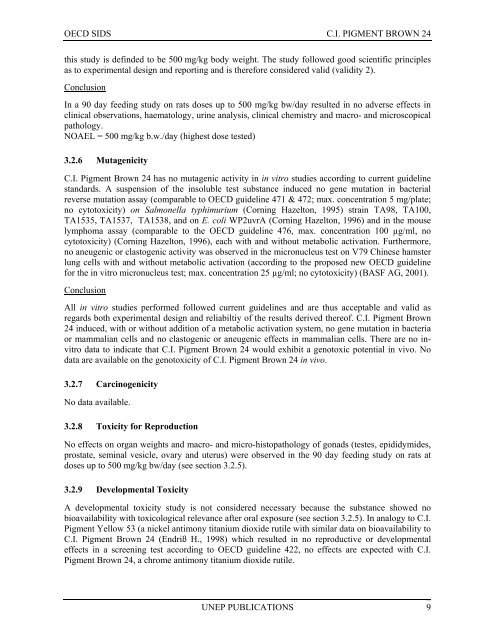C.I. Pigment Brown 24 CAS N°: 68186-90-3
C.I. Pigment Brown 24 CAS N°: 68186-90-3
C.I. Pigment Brown 24 CAS N°: 68186-90-3
You also want an ePaper? Increase the reach of your titles
YUMPU automatically turns print PDFs into web optimized ePapers that Google loves.
OECD SIDS C.I. PIGMENT BROWN <strong>24</strong><br />
this study is definded to be 500 mg/kg body weight. The study followed good scientific principles<br />
as to experimental design and reporting and is therefore considered valid (validity 2).<br />
Conclusion<br />
In a <strong>90</strong> day feeding study on rats doses up to 500 mg/kg bw/day resulted in no adverse effects in<br />
clinical observations, haematology, urine analysis, clinical chemistry and macro- and microscopical<br />
pathology.<br />
NOAEL = 500 mg/kg b.w./day (highest dose tested)<br />
3.2.6 Mutagenicity<br />
C.I. <strong>Pigment</strong> <strong>Brown</strong> <strong>24</strong> has no mutagenic activity in in vitro studies according to current guideline<br />
standards. A suspension of the insoluble test substance induced no gene mutation in bacterial<br />
reverse mutation assay (comparable to OECD guideline 471 & 472; max. concentration 5 mg/plate;<br />
no cytotoxicity) on Salmonella typhimurium (Corning Hazelton, 1995) strain TA98, TA100,<br />
TA1535, TA1537, TA1538, and on E. coli WP2uvrA (Corning Hazelton, 1996) and in the mouse<br />
lymphoma assay (comparable to the OECD guideline 476, max. concentration 100 µg/ml, no<br />
cytotoxicity) (Corning Hazelton, 1996), each with and without metabolic activation. Furthermore,<br />
no aneugenic or clastogenic activity was observed in the micronucleus test on V79 Chinese hamster<br />
lung cells with and without metabolic activation (according to the proposed new OECD guideline<br />
for the in vitro micronucleus test; max. concentration 25 µg/ml; no cytotoxicity) (BASF AG, 2001).<br />
Conclusion<br />
All in vitro studies performed followed current guidelines and are thus acceptable and valid as<br />
regards both experimental design and reliabiltiy of the results derived thereof. C.I. <strong>Pigment</strong> <strong>Brown</strong><br />
<strong>24</strong> induced, with or without addition of a metabolic activation system, no gene mutation in bacteria<br />
or mammalian cells and no clastogenic or aneugenic effects in mammalian cells. There are no invitro<br />
data to indicate that C.I. <strong>Pigment</strong> <strong>Brown</strong> <strong>24</strong> would exhibit a genotoxic potential in vivo. No<br />
data are available on the genotoxicity of C.I. <strong>Pigment</strong> <strong>Brown</strong> <strong>24</strong> in vivo.<br />
3.2.7 Carcinogenicity<br />
No data available.<br />
3.2.8 Toxicity for Reproduction<br />
No effects on organ weights and macro- and micro-histopathology of gonads (testes, epididymides,<br />
prostate, seminal vesicle, ovary and uterus) were observed in the <strong>90</strong> day feeding study on rats at<br />
doses up to 500 mg/kg bw/day (see section 3.2.5).<br />
3.2.9 Developmental Toxicity<br />
A developmental toxicity study is not considered necessary because the substance showed no<br />
bioavailability with toxicological relevance after oral exposure (see section 3.2.5). In analogy to C.I.<br />
<strong>Pigment</strong> Yellow 53 (a nickel antimony titanium dioxide rutile with similar data on bioavailability to<br />
C.I. <strong>Pigment</strong> <strong>Brown</strong> <strong>24</strong> (Endriß H., 1998) which resulted in no reproductive or developmental<br />
effects in a screening test according to OECD guideline 422, no effects are expected with C.I.<br />
<strong>Pigment</strong> <strong>Brown</strong> <strong>24</strong>, a chrome antimony titanium dioxide rutile.<br />
UNEP PUBLICATIONS 9

















